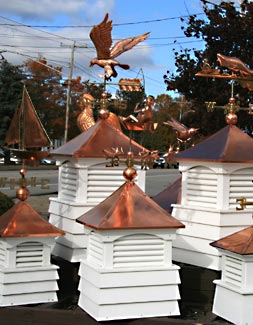Weathervanes of Maine Continues the Colonial Craft of Copper Weathervanes
 Copper Weathervanes by Weathervanes of Maine
Copper Weathervanes by Weathervanes of MainePhotograph by Greg Zachmann
As second generation coppersmiths who learned most everything they know about their craft from their father, brothers Paul and Bill McElvain began making copper weathervanes as a hobby that soon turned into a thriving family business.
Now, 30 years later, Weathervanes of Maine maintains four stores in New England - in the towns of Freeport and Wells in Maine, in the town of Conway in New Hampshire, and at their headquarters in Searsport, Maine. Paul and Bill design all of their products, and they maintain a staff to help them complete the work. Copper has been the material of choice for weathervanes since Colonial times, and the brothers continue this tradition.
"It's excellent for weathervanes because it's hollow and lightweight, but durable and weather-resistant, says Paul McElvain.
Of course, the construction is also an important component. Mass-produced weathervanes are not built to last through many years of storms, but Weathervanes of Maine uses only the highest quality copper and takes great care not only in the soldering work, but in the design itself. The center turning point of the weathervane must be taken into account to make sure it points directly where the wind is coming from, while also withstanding season after season of strong winds. For example, horses are one of the most popular weathervane designs.
"More than 70 percent of the body of the horse is going to be behind the center turning point and 30 percent in the front," Paul says. "When the wind comes at it, it's going to take the biggest part first and take that into the wind…The better [the weathervanes] go into the wind, the more they'll be able to take a strong wind."
The McElvains use several different kinds of copper. Animal designs are generally formed by hand using a steel cast mold, and the more malleable soft roll copper is pounded into the molds with a hammer. For more angular designs, such as airplanes and ships, a rigid sheet copper is used without a mold-these are cut and shaped rather than pounded.
The company maintains a large catalog of designs that run the gamut from a flying pig to an angel. The traditional rooster designs are still their biggest sellers, but the McElvains also make custom creations.
"There's nothing you can't get if you have enough money," Paul says with a chuckle.
 Copper weathervane close up
Copper weathervane close upPhotograph by Greg Zachmann
It is a testament to their artistry that they have made custom weathervanes for several high profile customers, such as Julie Andrews of "Mary Poppins" and "The Sound of Music", the Baseball Hall of Fame, the Governor's Mansion in Maine, and film director John Landis ("Animal House" and "The Blues Brothers"). The weathervane for Landis was a particular challenge. His wife ordered King Kong on top of the Empire State Building as a gift for the director.
The company also makes copper-roofed cupolas, birdhouses and bird feeders, as well as copper wall art. While the custom designs must sometimes, by necessity, be expensive, Paul is quick to note that their regular line is often very affordable. The company's weathervanes are also sold by Good Directions and Cape Cod Weathervane Company.
Weathervanes of Maine's attention to detail can easily be seen in the copper feathers of an eagle's wing or the keen likeness of a specific model of airplane. This fine craftsmanship is what has kept the company in business and growing since the 1970's.
Also in this Issue:
- Copper Keepsakes to Make your Holiday Shimmer
- Reggie Farmer: Modern Day Coppersmith
- The Changing Nature of Verdigris
- Weathervanes of Maine Continues the Colonial Craft of Copper Weathervanes
- Metropolitan Museum Offers Rare Viewing of Lorenzo Ghiberti's Gates of Paradise, Magnificent Renaissance Masterpiece
